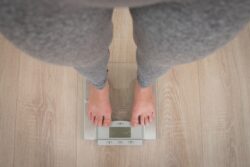Table of Contents
Can I Lose Fat Without Losing Weight?
You can lose fat without losing weight. I usually recommend that people weigh themselves every day or at least on the same scale on the same days each week to get a good idea of overall progress and not obsess about any single day’s weigh-in.
If you do this, then you may notice that the fat is coming off, but your weight seems stuck. This is because fat loss can be very slow and it doesn’t show up on a bathroom scale with any obvious speed.
The fat vs. muscle argument comes into play with two primary goals: fat loss and muscle gain (or muscle retention).
If you want fat loss and muscle gain, you can’t expect fat loss to be the only thing that’s happening. If fat is coming off and weight is also going down, there may be a lot of fat loss with little or no muscle gain.
The same problem occurs if fat gain accompanies weight gain: there isn’t much fat or weight gain.
Are weight loss and fat loss the same thing?
Maybe you’ve been fat your entire life and have never questioned the difference between fat loss vs weight loss, but for those of us who aren’t fat, the confusion can be a bit more pronounced.
Essentially they are two different things- one describes a fat loss per unit volume, while the other describes a fat loss per unit mass… that’s fat loss per weight, as opposed to fat loss per fat.
What is fat?
In simple terms, fat is a mass of stored metabolic energy. Energy that was either consumed from food or provided by the body itself during the fat storing process.
When fat cells expand due to an influx of fat and nutrients, they become full of energy potential, which can be expelled when fat cells shrink back down during fat usage.
What is weight?
Weight is a measure of gravity’s pull on an object. Now, you’re probably asking “What does that have to do with fat loss?”
The answer lies in how fat loss works- fat doesn’t just disappear into thin air (or thin fat, as it were). It has to be burned off by the body. The fat cells shrink down and the energy within is dispersed into fat tissue cells around the body, but this energy cannot just disappear or it would violate laws of physics.
What happens when fat is “lost”
As fat cells lose mass due to fat usage they shrink in size and the fat tissue cells around the body lose energy (fat). But this fat loss is not absolutely equal across all fat cells.
Because fat cells vary in size, different fat cells will shrink to different degrees for a net level of fat loss- resulting in some fat cell areas losing more fat than others.
How fat loss vs weight loss works?
So fat loss is the fat tissue cells around your body losing fat that they have stored, and weight is just a measure of how much mass you have.
So when you lose fat mass but keep the same amount of weight (and thus, fat), fat loss has occurred even though your overall weight hasn’t changed.
What’s the difference between weight loss and fat loss?
While fat loss and weight loss are usually used in the same context, fat loss really means losing fat. There’s an important difference to understand when you’re trying to lose fat.
When you cut calories with the goal of weight loss, your focus is on reducing fat mass through a calorie deficit, but when you’re focusing on fat loss, your goal is to lose fat while also maintaining or even building muscle.
In other words, fat loss means losing fat with a specific diet and exercise plan designed for fat loss—in particular, one with a calorie deficit created by eating fewer calories from fat and/or burning more calories through physical activity.
If you just reduce the number of calories and fat grams you eat or try to lose fat without considering the effects on fat-free mass, fat loss may not happen.
On the other hand, weight loss means losing fat along with muscle, water weight and some organ tissue due to a calorie deficit created by eating fewer calories from food in general or burning more calories through increased activity.
If you want to lose fat, you must use a fat loss plan specifically designed for fat loss.
Just make fat loss your goal- not weight loss
When fat loss is your goal (not weight loss), consider these tips: Get plenty of protein. A high-protein diet not only helps keep you feeling satisfied, it also preserves muscle mass and can help boost your metabolism.
Eat more fiber. Eating foods that contain fiber may help you lose fat because they take your body a long time to digest. Get enough fat, but not too much.
Eating fat can help you lose fat—in particular, omega-3 fatty acids and monounsaturated fats may speed up fat loss by boosting the calorie burning rate of your metabolism—but don’t eat so much fat that you negate fat-burning benefits of fat by overloading on calories. Make sure your food choices are right for fat loss. Eating nutrient-rich, low-energy foods helps you make the best possible food choices for fat loss while still giving your body the fuel it needs to perform its daily functions.
When fat loss is your goal, make fat loss foods like chicken breast, salmon and spinach a regular part of your meals. Avoid fat-promoting foods such as fried foods, processed baked goods and snack chips.
Tip: Here’s an easy way to incorporate more fat-fighting foods into your meal plan: Put fat loss ingredients on your shopping list.
If you’re going to the grocery store to buy fat loss foods, put chicken breast, salmon and spinach on your list so you’ll remember to include them when meal-planning.
